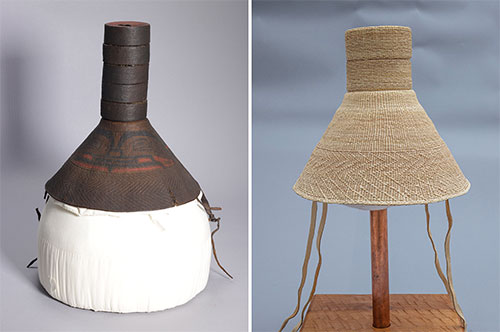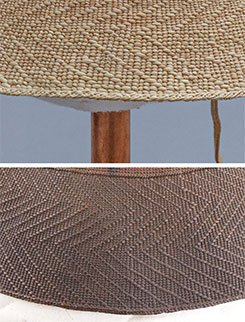
ARTISTS STUDYING OLD SPRUCE-ROOT HAT DISCOVER NEW WEAVING TECHNIQUE
December 15, 2020
Haida master weaver Delores Churchill and her apprentice, Tlingit and Haida artist Debbie Aanutein Head, made the find while studying an old spruce-root hat housed at the Alaska State Museum. Through the mentorship program, Head was tasked with weaving a spruce-root hat similar to the museum’s so-called “Wilbur hat” (above left). The piece was collected by Dr. B. K. Wilbur, who was the physician at the Sitka Industrial School in the 1890s and early 1900s, said the museum’s Curator of Collections Steve Henrikson.
“The Wilbur hat is one of the most finely woven spruce-root hats I’ve ever seen,” said Henrikson, adding it was likely collected in Sitka. When Head reached the brim’s border of her hat (above right), which is the most difficult part to execute, she traveled to Ketchikan seeking guidance from Churchill. The women, referencing close-up photos of the old hat, didn’t recognize the weaving technique used on its border.
Churchill studied the hat and, through trial and error over four days, eventually wove a border that appeared to be a replica of the old hat’s pattern (right), which was an ending she had never seen before. Churchill, a scholar who has studied spruce-root weaving techniques the world over, and Head, who has spent years specifically studying borders on hat brims and baskets in collections across the country, realized the importance of the moment. “It was like finding a giant gold nugget that’s been buried for thousands of years. I got to watch Delores dig the trench and pull it out of the ground. It’s been one of the highlights of my year, period”! Head said to SHI’s art director, Kari Groven. As a teacher, Churchill has been instrumental in revitalizing the endangered ancient practice of spruce-root weaving throughout the region. Her contributions in the field are considered to be so significant that the artist-in-residence space at Sealaska Heritage in 2015 was named in her honor. Through her work, she has mentored many weaving students and is privy to much of their work, but if there are contemporary weavers using the technique seen on the old hat, she is hoping they will reach out. “To the best of our knowledge, this technique is not being used, but if it is, please let us know,” Churchill said. This is not the first time Churchill has discovered a lost weaving technique. In 1999, the remains of a Tlingit man and a spruce-root hat thought to be around 600 years old were discovered in a melting glacier in British Columbia. SHI sponsored Churchill to study the old hat, and through that research she discovered a weaving technique that had been lost. Churchill made a replica of the hat, which now resides in SHI’s collection. Head’s hat, which is inspired by the Wilbur hat, also is now in SHI’s collection. The hat is known as a shadakóox?’ — which translates as “woven root hat with a stack of basket-like cylinders on top.” Churchill says this is likely the first Tlingit shadakóox?’ hat made in more than 100 years or perhaps even 150 years because George Emmons, an ethnographic photographer who collected Alaska Native pieces in the late 1800s, had a difficult time finding any Tlingits who made them, Churchill said. “People just stopped teaching it because it was too difficult,” Churchill said. Churchill’s mother, the famed late weaver Selina Peratrovich, kept the knowledge alive, and some weavers in recent years have made Haida ringed hats, which differ slightly from the techniques used in Tlingit spruce-root weaving. Head’s hat will be made available to weaving students for study, said SHI President Rosita Worl. “The amount of time and scholarship that went into the creation of Debbie’s hat is extraordinary, and the fact they discovered this ‘new’ technique makes it all the more remarkable,” Worl said. “We believe our ancestors guided them to bring this knowledge back to us, and we are thrilled to have a modern and yet ancient version of a Tlingit shadakóox?’ hat in our collection.” In an interview, Churchill reflected on her life’s work in revitalizing spruce-root weaving. “It has been so exciting to bring back interest in spruce-root weaving. The response has been beyond my wildest dreams,” Churchill said. Churchill and Head are now hoping to raise funds to write a book documenting all of the spruce-root endings they’ve found over the years.
Source of News:
|
|||||


